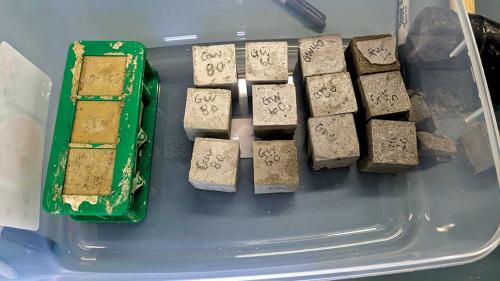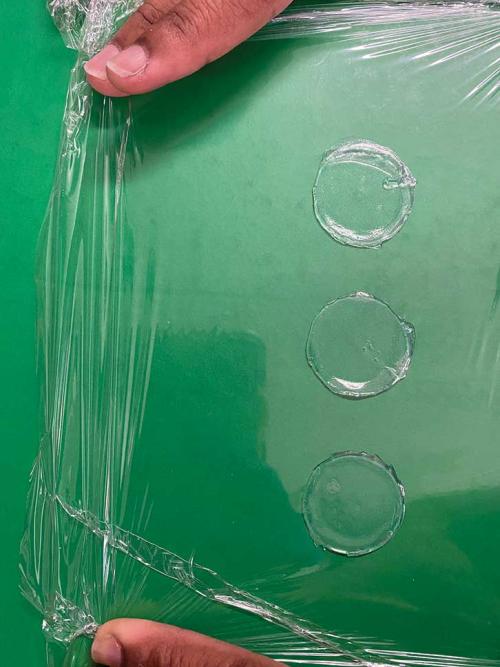One of the advantages of working in a multidisciplinary team is that the combination of expertise can help accelerate tackling broad and complex problems such as how to prevent ‘waste’ material from having a detrimental environment impact. There is value in acknowledging that there is no such thing as waste, just a material that has not found a ‘home’ or follow-on use yet.
With ‘value’ being the key word, the current focus in the waste material research space has not only been on the technical approaches for transforming product manufacture, but has also been on their viability (e.g. financial and ease of implementation). This is because viability of the solution is key to uptake into common practice. In a circular economy, the ways in which we design how to construct and deconstruct products both physically and chemically so that they are re-usable, be it through recycling, remanufacture, repair or refurbishment.
With this purpose, our team, consisting of a wide variety of engineers, scientists, and education and business academics focuses on transforming product manufacture and supply chains to be sustainable. The industry sectors of focus for our work include the food, medical, construction, resource and energy sectors. At times, the collaboration of these industries is one strategy to prevent ‘waste’ from going to landfill. The technical approaches vary for each sector but focus on the development of processes that are not overly complicated, are potentially easy to implement and have low energy intensity. The other area of focus is design of products that are easy to construct and deconstruct, to make recovery of separate material streams easier as many products are what we might term ‘composite materials’.
Here we showcase a series of work carried out under our team’s major funded programs supported by the Australian Department of Education’s Strategic University Reform Fund and their Regional Research Collaboration scheme. These programs are the New Options for Waste and Saving The Environment (NO WASTE) pilot precinct and the Sustainable Industry Manufacturing Planning for Long-term Ecosystems (SIMPLE) hub, led out of the University of Southern Queensland in Toowoomba.
A touch of glass
In Australia, we use approximately 1.3 megatonnes of glass each year. The composition of the glass types used can vary, complicating their recycling if we have mixed glass streams. Many people are familiar with bottle glass and many of the recycling schemes that have been implemented nationally and are growing due to the inherent ability of glass to be recycled multiple times. However, in the movement of collected glass bottles to recycling, there are some issues with glass mixing, fines generated where cullet (scraps of broken or waste glass gathered for remelting) is required and contamination leaving some material still to be utilised. In addition, the issue of other types of glasses from other sources, such as solar panels, automotive glass and construction glass, still needs to be resolved because of the glass composition and the composite nature of these products (containing items other than glass).
Our team’s recent work has shown that brown, green and clear glass perform differently from each other in applications such as concrete and grout, affecting the behaviour of water and its required amount in a mix formulation. One of the challenges of use in these applications is that although there has been a lot of work in this space and adoption in some industry applications, the longevity of these products still needs further examination due to potential alkali silica reaction of cement with the glass (see bit.ly/3mZF0xQ for reaction details), commonly known as concrete cancer, that could be detrimental to structural integrity. Our team has focused on some prevention strategies including:
- coating the glass particles with other ‘waste’ materials, including different plastics, thereby dealing with two waste streams at once
- some novel process intensification combining cleaning and milling steps to accelerate size reduction and prevent alkali silica reaction through this approach.
Such a card
Although we have had a long history of recycling cardboard and paper in Australia, there are a limited number of times this can be done before structural integrity is affected. Another complication is that many paperboard and cardboard products may be coated, typically with a polymeric coating, sometimes a wax, which means that they cannot be recycled with the usual cardboard and paper recycling streams. These may be in the form of items such as the humble cardboard box or coffee cup. There is much change occurring in how we may use the takeaway coffee cup in future – whether it remains as a coated paperboard or as a keep cup type alternative, there are challenges to be overcome. Until full bans on single-use coffee cups are implemented more widely, there is a problem of an estimated 1 billion single-use coffee cups being used in Australia every year – that’s a lotta lattes! But did you know that we can use the inherent composite nature of the humble single-use coffee cup to make products potentially as strong as MDF (medium density fibreboard)? The mechanical properties of such a product can be tailored by controlling the amount of coated interfacial area in contact in pressed ‘cup-board’ as shown in the images, which had polyethylene coating. This can be controlled through the size reduction of the cups from none (just pressing stacked cups) through to finely milled cups, creating a compressible fluffy fibre.
Food for thought
As part of the team’s work, some of the research focus is on materials and products derived from sustainable natural sources. One area of the team’s work concentrates on extraction of ‘molecules of interest’ from food excess and by-products and refinement into useful and high-value products, which we have described previously. Some of the materials and substances of interest include structuring molecules, typically pectin and cellulose biopolymers, which can be used for development of novel films, hydrogels and structured particles to fit a range of applications, and smaller micronutrient molecules with potentially useful biological functions.
One of the first challenges of extracting these substances is ensuring that the raw material feedstock is appropriately preserved with suitable resource use. Some approaches can be energy intensive, particularly drying approaches, but naturally sourced preservatives can assist in shelf-life extension until processing can occur. Some of our team’s work has focused on the use of anthocyanin from excess food sources as a useful molecule to aid healing and as a biosensor to indicate wound pH and health status, thereby having a two-pronged therapeutic function without being too high tech or expensive. This makes it ideal for applications in rural, regional or remote areas where health resourcing can be limited. We have also developed a rapid analysis technique and colour correlation to track fresh fruit anthocyanin development to help pinpoint the optimal harvest point for maximum anthocyanin content. This has the opportunity to optimise the value of the fruit and the products it can be transformed into, which may have high-value applications in cosmetics or health.
Golden opportunity
Citrus fruits are a great source of not only useful micronutrients but also structural biopolymers such as pectins and celluloses. In juicing applications, these are often lost through discard of the pomace by-product (the pulp left behind after juicing). Again, one of the challenges is the timely preservation of this material to prevent excessive microbial load before it can be used, with high-volume juicing manufacturing producing several tonnes of this material. One of our projects with this very useful material focused on developing a range of products through a series of (confidential) process steps including pectin-based hydrogels and a liquid-extracted ‘syrup’ useful for fermentation into novel cellulosic materials. The focus was on uncomplicated processing approaches to achieve these outcomes. As a result, the ‘syrup’ will now form the basis of a future project extending the structured cellulose formation from ‘waste’. This is advantageous because it lowers the cost of producing these types of products by fermentation techniques if the feedstock is produced from this by-product. The feedstock source will also influence the subsequent material properties including strength, colour and porosity helping tailor them for a range of applications. Cellulose is very versatile; not only is it useful for making paper but it can also be used for higher-tech applications such as batteries and acoustic materials.
Plastic fantastic
We carry out a range of work focused on preventing plastic waste, which in some instances is considered not only an environmental issue but also a health one (e.g. microplastics). Plastic has become ubiquitous for many applications such as packaging, PPE, electronics and automotive. Many of the issues lie with single-use items and those that end up in commingled recovery streams requiring many steps such as sorting, cleaning and pre-processing before they can be used in typical plastic manufacturing processes.
With our industry partner, Talon Technology, we have been turning that on its head by utilising the inherent nature of plastic mixtures to create products that contain more than 95% mixed waste. Effectively, these are all plastic composites with a low melting point polymer matrix, incorporating higher melting point reinforcement. Similar to the coated cardboard and paperboard examples, the integrity and strength of these materials rely on controlling the size of the interfacial surfaces in contact and the strength of the bonds that form. These have shown to have significant mechanical performance, excess to product requirements for certain applications. One of the challenges is to then change perceptions of how this may compare to a single pure material product performing the same function with a narrower band of performance or tolerance. Another consideration is how this may change how we approach product standards.
The near future
Some of our team have worked on fibre composite design and advanced manufacturing. These materials can be used for a range of applications including automotive, aerospace, marine, infrastructure and energy applications (e.g. wind turbines). Several strategies are being developed globally to deal with end-of-life fibre composites that include their use in other products, as well as some clever chemistry design to recover either the resin component or the fibre component. Because of the growing volume of fibre composite items that will end their service life, tackling this problem at scale is necessary. Our team will be focusing on tailored approaches to recover both resin and fibre appropriately.
Technology is impactful, behaviour change more so. As part of our research program, as well as the technical research, we have a broad-reaching education stream targeting everyone from prep age upwards on how we can transition from discarding materials to transforming them into useful items. This helps in the co-design of solutions so that potential users may feel more ownership. The focus is on strategies that are uncomplicated, financially viable, and able to be implemented and designed as fit for the geographical environment in which they are located (be it regional or metropolitan).
The opportunity to transition from linear pathways for material to more circular or ‘loopy’ pathways is significant and the benefits are broad. Through collaboration in this fascinating chemical and materials space we can progress towards ‘no waste’.








